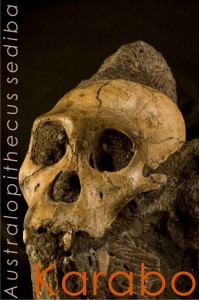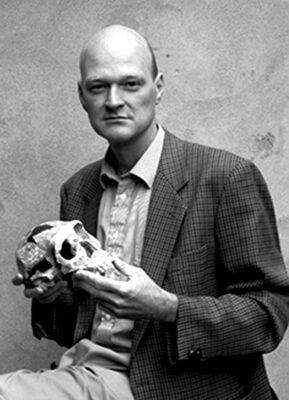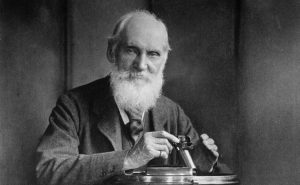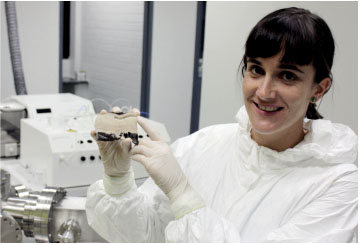 In the journal Science September 9 edition, a collection of reports generated a storm of controversy on the evolution status of Australopithecus sediba. Nicknamed Karabo, meaning “answers,” the fossils have emerged as the latest human ancestor candidate.
In the journal Science September 9 edition, a collection of reports generated a storm of controversy on the evolution status of Australopithecus sediba. Nicknamed Karabo, meaning “answers,” the fossils have emerged as the latest human ancestor candidate.
While last week’s topic focused on Karabo’s transitional links, this week examines the dating of these two remarkable fossilized skeletons recovered from the Malapa site in South Africa. The dating of Karabo was surprising.
Robyn Pickering (pictured right), a geochemist specializing in the dating of early hominid sites, calculated and incorporated the date into the title of the report: “Australopithecus sediba at 1.977 Ma, and Implications for the Origins of the Genus Homo.” Using a uranium-lead (U-Ph) dating method, The 1.977 + 0.002 million years date is far earlier than expected. Ironically, the dating of Karabo raises more questions than answers.
Dating of Karabo
Given the quality of the skeletons with a mix of morphological characteristics, the unexpected dating of Karabo is challenging human evolution orthodoxy. Donald Johanson (pictured left), a paleoanthropologist at Arizona State University and founder of the Institute of Human Origins at the University of California, Berkeley, emailed writer Nicholas Wade at The New York Times for the article entitled “New Fossils May Redraw Human Ancestry,” the dating surprise –
“[This] places the origins of Homo firmly in eastern Africa… [but] prior to the dating of A. sediba.”
Amina Khan, in the Los Angeles Times article “Hominid fossils may shake up the human family tree,” explained the dating issue –
“The age of the fossils presents a problem. The researchers’ isotopic and magnetic dating showed the fossils were 1.977 million years old, about 300,000 years younger than a Homo habilis fossil that should have been their junior.”
Paleoanthropologist Fred Spoor (pictured right) of University College London and the Max Planck Institute for Evolutionary Anthropology in Leipzig, Germany, explains the dating problem in the journal of Nature (2011) –
“It will… be difficult to uphold the suggestion that the extensive evolutionary change required could have occurred in the time available.”
Equivocal Evidence
The dating of Karabo is only one of a list of issues with equivocal evidence, however. The fossil record has yet to persuade many anthropologists. Dating only compounds the problem. Ann Gibbons, in her article published with the collection of Science reports entitled “Skeletons Present an Exquisite Paleo-Puzzle,” explains –
“Few other researchers are convinced that Au. sediba was a direct ancestor of humans—but most don’t rule out that possibility.”
The fossil record continues as a yet unsolvable issue. As a result, a consensus on a comprehensive theory of human evolution by means of natural selection remains beyond the reach of science. Last year, in 2010, Science published Johanson’s article entitle “Candidate Human Ancestor [Karabo] From South Africa Sparks Praise and Debate,” which explains the problem –
“The oldest Homo specimens are scrappy and enigmatic, leaving researchers unsure about the evolutionary steps between the australopithecines and Homo. … The transition to Homo continues to be almost totally confusing.”
 Ned Potter (pictured left), a science and technology writer for ABC News, in the article “Evolutionary ‘Game Changer’: Fossil May Be Human Ancestor,” with the subtitle “bones, 2 million years old, from South Africa may prove link in evolution theory,” explains –
Ned Potter (pictured left), a science and technology writer for ABC News, in the article “Evolutionary ‘Game Changer’: Fossil May Be Human Ancestor,” with the subtitle “bones, 2 million years old, from South Africa may prove link in evolution theory,” explains –
“Scientists have long talked about a ‘missing link’ between very old fossils… There is a gap in the fossil record, so far unexplained. Does Australopithecus sediba help fill the gap? Not on its own, say most researchers…”
“The team says the new species may be the best candidate yet as an immediate ancestor of our genus, Homo,” wrote Michael Balter, Science staff writer. In the article “Paleoanthropologist Now Rides High on a New Fossil Tide,” however, Balter concedes –
“That last claim is a big one, and few scientists are ready to believe it themselves just yet.”
2010 Karabo Take-Aways
Few paleontologists agreed with Lee Berger’s interpretation of his initial findings published in the journal of Science from the same Malapa site in South Africa in 2010. Writing in Science, paleoanthropologist and Professor of Integrative Biology at the University of California, Berkeley, Tim White pointed out in 2010 –
“Given its late age and Australopithecus-grade anatomy, it contributes little to the understanding of the origin of genus Homo.”
Time magazine reported in the article entitled “Found in South Africa: Key Link in Human Evolution?” in the 2010 April 8 issue, simply states –
“Tim White … believes A. Sediba bears no relationship to modern humans.”
After reviewing the most recent papers in Science, Professor of Human Origins at George Washington University, Bernard Wood (pictured right), concluded –
“[These are] a watershed in our understanding of human evolution, even if only to demonstrate that things are pretty complex.”
Ian Tattersall, paleoanthropologist and a curator at the American Museum of Natural History, resigned to the fact that the fossil record evidence may never disclose any “leap to humans” since it happened “very suddenly.”
In the century following the publication of The Origin of Species in 1859, the fossil record has proved to be a bust undermining the scientific validity of Charles Darwin’s theory of evolution. As Steven Gould noted in The Panda’s Thumb –
“The fossil record had caused Darwin more grief than joy.”
Genesis
 Except for Pickering’s dating of Karabo, the fossil record evidence is compatible with the Genesis account written by Moses, Pickering’s dating of Karabo only further intensifies Darwin’s dilemma.
Except for Pickering’s dating of Karabo, the fossil record evidence is compatible with the Genesis account written by Moses, Pickering’s dating of Karabo only further intensifies Darwin’s dilemma.
Lord William Thomson Kevin, an Irish mathematical physicist, and engineer who formulated the first and second laws of thermodynamics and noted during the Scientific Revolution –
“We must pause, face to face with the mystery and miracle of the creation of living creatures.”
Refer to the Glossary for the definition of terms and to Understanding Evolution to gain insights into understanding evolution.
2020 Update
The journal of Science, 2013
Lee R. Berger, the original discovery of Karabo, in the article entitled The Mosaic Nature of Australopithecus sediba,” published in the April 12 edition of the journal of Science in 2013, concludes –
“This examination of a large number of associated, often complete, and undistorted elements gives us a glimpse of a hominin species that appears to be mosaic in its anatomy and that presents a suite of functional complexes that are different from both those predicted for other australopiths and those of early Homo.”
Journal of Science Advances, 2019
Andrew Du of the University of Chicago, in the article entitled “Temporal evidence shows Australopithecus sediba is unlikely to be the ancestor of Homo,” published in the May 8 edition of the journal Science Advances in 2019, explains –
“Together, these results suggest it is highly unlikely that A. sediba is ancestral to Homo, and the most viable candidate ancestral species remains Australopithecus afarensis.”
WIKIPEDIA, 2020
A dating of Australopithecus sediba is not detailed, but Australopithecus as a Genus is listed as in the Pliocene era, 2.5 to 5.3 million years ago.
Evolution 101, 2020
No written presentation of Australopithecus sediba appears, and the human tree of life diagram does not include Australopithecus sediba.
Smithsonian, 2020
On the Human Fossils Species page, Australopithecus sediba appears along with the twenty other human-like species. A human tree of life diagram, updated in 2019, includes Australopithecus sediba dated 2 million years ago.


